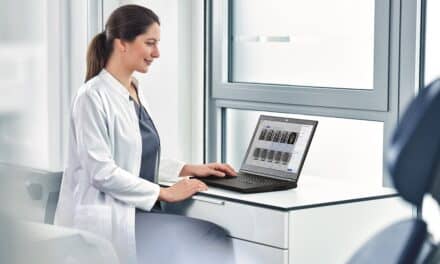Orthodontists are turning to 3D printing in-office to produce aligners, citing treatment control, cost savings, and faster turnaround times.
By Jane Kollmer
Orthodontists are increasingly installing 3D printers in their practices and printing their own retainers and aligners, often cutting out clear aligner manufacturers and third-party orthodontic labs. In-office printing has become popular across the globe because orthodontists realize as the technology advances, their practices are able to reap the benefits of treatment control, cost savings, and faster turnaround times.
“[In-office] aligners truly started becoming a trend in 2013 when SureSmile gave orthodontists the ability to stage and 3D print aligners [in-office],” says Edward Y. Lin, DDS, MS, a partner at Orthodontics Specialists of Green Bay with two private practices in Green Bay, Wis. “Since that time, this trend has been rapidly accelerating with many other competitors in the market such as uLab Systems and ArchForm, just to name a couple.”
Since 2013, Lin has fully implemented 3D printing into his practice; and his offices now produce all aligners in-office with uLab. As an early adopter, Lin says he has experienced the evolution of aligner treatment from inception and seen it advance to this newest generation of aligner therapy that gives orthodontists the control they want and is fully optimizable depending on the target result. He also frequently lectures and consults on orthodontic 3D printing technologies at international conferences.
At his practice, he explains they no longer use Invisalign because it is not cost-effective for them or their patients. Instead, they utilize uLab because they believe it is a more powerful aligner software application and is more cost-effective.
“Invisalign’s major patents have all expired in October of 2017 and truly for me it is an overpriced and outdated program similar to cable and satellite TV versus streaming video,” he says.
Invisalign is still the most recognizable brand name, but they no longer dominate the invisible aligner marketplace like they have for the past couple of decades.
“An open clear aligner market is going to benefit everyone from doctors to patients,” says Christian Groth, DDS, MS, of TDR Orthodontics in Michigan. “The more options available, the more they will drive innovation, drive product development, and as a result, we will have better products, and a better range of products that come down in price so that we can offer more treatment to more people.”
Groth is a leading advocate of in-office clear aligner production. He considers his decision to produce clear aligners in-office to be one of the most important he’s made at his practice.
“We’re at this tipping point with 3D printing and orthodontics,” he says. “Two years ago, 30% of offices had a 3D printer and they weren’t really utilizing it a lot. Now we’re much closer to 50% of offices having a 3D printer and they’re starting to use it for more.”
Groth says 3D printing in-office has become more widespread because “the applications are growing, the software is getting easier, and people are seeing this return on investment very quickly.”
“And frankly, just switching your retainers over to be made by 3D printing is going to pay for the printer in a relatively short period of time.”
Benefits to practice and patients
Many orthodontic practices are switching from outsourcing to manufacturing themselves because of the potential of seeing large cost savings over time.
“There’s no doubt that when you look at it, it will save expenses, but it will vary greatly depending on staff and materials,” Groth says. “But in general, the accepted range of aligner costs to do it [in-office] is somewhere between $15 and $25 per stage.”
He adds if it costs the practice less, it’s going to cost the patient less.
3D printing allows the workflow for straightening teeth to be mostly digital and saves time that would be spent on outsourcing, according to Jep Paschal, DMD, MS, owner of Paschal Orthodontics in Georgia.
“We’re scanning the patient’s mouth at their initial exam, putting the file on a computer, and then there’s various programs that will allow us to separate the teeth out so that we can subsequently move those teeth to where we want to put them and then establish a number of aligner steps that those teeth will move through to get to that end goal.”
Some orthodontists report that they are providing better and more efficient treatment to their patients by using 3D printers in-office.
“Our menu of options of how we treat people is ever expanding and it’s just going to keep growing,” Groth says. “Every office essentially is going to have every option and be able to use whatever combination or hybrid model benefits patients the most.”
With in-office printing being so affordable, Paschal says a lot of the treatment plans now help get patients out of braces sooner because they can be switched to aligners once the braces have done most of the heavy lifting. Orthodontists now have the capability to mix and match treatment protocols within their office.
“For our patients and for me as a practitioner, the biggest thing about 3D printing is being able to adapt these custom treatment plans to your patients’ needs and still keep it relatively affordable for them,” he says. “It’s kind of like being a painter and being given more colors to paint with.”
Having a 3D printer and scanner also makes it easier on patients coming in to get their braces removed. Paschal says he now spreads the debond phase over two appointments. The first one, he scans patients with their braces on, removes the braces digitally, prints a model with the 3D printer, and then manufactures the aligners. The next appointment will be their debond appointment, and they can take their retainer or clear aligners home with them.
“Now we don’t have to disappoint the patient. We save an appointment. That saves chair time, it saves money for the practice, and it creates a very joyous occasion for the patient because they still get their braces off,” he says.
Getting 3D printing set up
Orthodontists looking to take the leap into 3D printing need to consider several factors before converting part of their office into a lab.
“There is an upfront investment to set up a 3D printing lab with facility, hardware, and training,” says Lin. “3D printers in private orthodontic practices realistically can cost anywhere from $4,000 to $50,000. There is also the investment with the facility with proper electrical and fiber wiring, plumbing, and air compression.”
Groth says that the type of printer that is right for a practice depends on what they want to print and how often they will need to use it. For example, certain printers are designed without the ability to switch the material. If a practice wants to only print models to make in-office aligners and retainers, they have several options.
“There are some printers that are single material printers that are great and fast and sometimes less expensive,” he says.
However, printing a variety of appliances—such as print models for retainers and bite splints, nightguards and indirect bonding trays—requires a different type of printer that allows for different materials.
And the amount of printing a practice needs to do will determine the number and type of printers. Groth runs a busy commercial printing lab that has the capacity to print over a thousand a day. In contrast, a small office with minimal volume may be able to use a single printer. A mid- to large-sized office, however, may need larger or a greater number of printers in order to keep up with the volume and build redundancy into the system in the event that a printer is offline for maintenance.
To get started, Paschal recommends that practices onboard 3D printing incrementally. These steps include buying the first printer, working with it, and testing workflows. And then as they grow and do more printed appliances or aligners, they can buy another printer.
“Technology increases at such a rate that most likely the next printer you’re buying is going to be a printer that’s got either physical updates or software updates,” Paschal says. “At any given time, you’re going to have the latest and greatest printer and your original printer, or your last two printers, are going to be your legacy printers.”
And as Groth pointed out, many practices prefer to have more than one printer for redundancy in case one experiences a technical issue.
“The more dependent you get on 3D printing in your office, you’ve got to have backups,” says Paschal, adding that orthodontists should think like manufacturers and develop protocols for when a print fails. “It does add a level of complexity to your office, but at the end of the day, it expands your scope of care that you can deliver to your patients.”
After hardware, staffing is a major consideration. Ultimately, the person running the 3D printing lab should not be the orthodontist because their time is too costly. Lin says, “As 3D printing grew in our practice, I realized that we needed to have someone with a stronger technology skillset to manage our 3D printing lab.”
And that job can get a bit messy. As Groth points out, the resin material used to form the aligners has a honey-like consistency, so there is potential for messes. He suggests putting the printer in its own space, away from dust and vibrations, and a lot of traffic.
“You need a very organized, clean person to run these,” he says. “And the learning curve really depends on the tech abilities of the person.”
Trends to come
According to Paschal, the materials that orthodontists print with are improving every day.
“The chemists are really figuring out how to tweak these different materials to our unique needs,” he says. “A great example is in general dentistry where they are 3D printing crowns and bridges and implant-supported fixed dentures using long-lasting, porcelain-infused materials.”
The applications for 3D printing in orthodontics continue to grow and are heading into producing more advanced appliances.
“We’re printing things that you literally cannot manufacture from a traditional standpoint,” Groth says. “There are geometries I can 3D print that cannot be injection molded because it’s physically impossible.”
He predicts that in 5 years, every orthodontic treatment is going to be customized.
“I think it’s really going to be really exciting to see what we’re able to do 12-, 24-, 36-months from now with this influx of interest, because every young orthodontist out there, they’re coming into the office with the expectation that 3D printing is going to be a part of what they do.”
Jane Kollmer is a contributing writer for Orthodontic Products.










